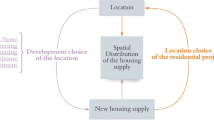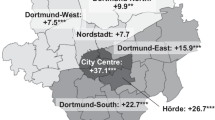Abstract
Housing prices in the Lyon Urban area are simulated with the land use framework UrbanSim interacting with the transportation model MOSART. We focus on the Real Estate Price Model of the UrbanSim framework, which proposes the ordinary least square regression. In our simulation, the alternative geographically weighted regression methodology is applied. The model of housing prices is calibrated using a nine-year back-casting period. The calibrated model, applied in simulation, provides price dynamics similar to actual one in the very centre of Lyon. Farther from the city centre, where the available data on actual sales exist, simulated prices tend to be understated. Thus, mainly only the most central locations manifest realistic price dynamics. Sensitivity analysis demonstrates the model’s ability to capture changes in employment accessibility on price dynamics.





Similar content being viewed by others
Notes
In the historical arrondissements Lyon 1 and Lyon 4 located between the two rivers, there is no free space for new residential development, and new construction in fact does not take place; therefore a number of residential units is not updated there. Demolition is not included into the current version of the UrbanSim framework.
MOdélisation et Simulation de l’Accessibilité aux Réseaux et aux Territoires (Modelling and Simulation of Accessibility to Networks and Territories).
The inverse distance weighted method is applied with 12 neighbors, power 2 and cell size of 10 m. The method generates results, which are closer to real values, than in the case of Kriging.
This alternative modeling strategy was implemented only to illustrate the influence of residential supply. In the final version of the calibration as well as in the simulation, residential units are constructed yearly.
Adoptive kernel type is not appropriate to our aggregated data, perhaps due to leaps of prices and other characteristics between neighboring municipalities.
References
Anselin, L.: Thirty years of spatial econometrics. Pap. Reg. Sci. 89, 3–25 (2010)
Bonnafous, A., Kryvobokov, M.: Insight into apartment attributes and location with factors and principal components. Int. J. Hous. Mark. Anal. 4, 155–171 (2011)
Bonnafous, A., Crozet, Y., Mercier, A., Ovtracht, N., Péguy, P.-Y., Puech, F.: MOSART et le projet PLAINSUDD : une plate-forme de modélisation et simulation de l’accessibilité pour l’aide à la décision et l’aménagement du territoire. In: Antoni, J.-P. (ed.) Modéliser la ville : formes urbaines et politiques de transport, pp. 186–210. Economica (2011)
Bonnafous, A., Kryvobokov, M., Bouf, D., Ovtracht, N.: Simulating residential location choice in the Lyon Urban Area. Conference paper, 57th Annual North American Meetings of the Regional Science Association International, Denver, Colorado, 10–13 November (2010)
Briassoulis, H.: Policy-oriented integrated analysis of land-use change: an analysis of data needs. Environ. Manag. 27, 1–11 (2001)
Brunsdon, C.F., Fotheringham, A.S., Charlton, M.E.: Geographically weighted regression: a method for exploring spatial nonstationarity. Geogr. Anal. 28, 281–298 (1996)
Chang, J.S.: Models of the relationship between transport and land-use: a review. Transp. Rev. 26, 325–350 (2006)
de Palma, A., Motamedi, K., Picard, N., Waddell, P.: A model of residential location choice with endogenous housing prices and traffic for the Paris region. Eur. Transp. 31, 67–82 (2005)
de Palma, A., Picard, N., Waddell, P.: Discrete choice model with capacity constraints: an empirical analysis of the housing market of the greater Paris region. J. Urban Econ. 62, 204–230 (2007)
DiPasquale, D., Somerville, C.T.: Do house price indices based on transacting units represent the entire stock? Evidence from the American housing survey. J. Hous. Econ. 4, 195–229 (1995)
DiPasquale, D., Wheaton, W.C.: Housing market dynamics and the future of housing prices. J. Urban Econ. 35, 1–27 (1994)
Di Zio, S., Montanari, A., Staniscia, B.: Simulation of urban development in the city of Rome: framework, methodology, and problem solving. J. Transp. Land Use 3, 85–105 (2010)
Felsenstein, D., Ashbel, E.: Simultaneous modelling of developer behavior and land prices in UrbanSim. J. Transp. Land Use 3, 107–127 (2010)
Geurs, K.T., van Wee, B.: Accessibility evaluation of land-use and transport strategies: review and research directions. J. Transp. Geogr. 12, 127–140 (2004)
Handy, S.L., Niemeier, D.A.: Measuring accessibility: an exploration of issues and alternatives. Environ. Plan. A 29, 1175–1194 (1997)
Hunt, J.D., Kriger, D.S., Miller, E.J.: Current operational urban land-use-transport modelling frameworks: a review. Transp. Rev. 25, 329–376 (2005)
Iacono, M., Levinson, D., El-Geneidy, A.: Models of transportation and land use change: a guide to the territory. J. Plan. Lit. 22, 323–340 (2008)
Kryvobokov, M.: Is it worth identifying service employment (sub)centres when modelling apartment prices? J. Prop. Res. 27, 371–390 (2010)
Löchl, M., Axhausen, K.W.: Modelling hedonic residential rents for land use and transport simulation while considering spatial effects. J. Transp. Land Use 3, 39–63 (2010)
Malpezzi, S.A.: Simple error correction model of house prices. J. Hous. Econ. 8, 27–62 (1999)
Moeckel, R., Spiekermann, K., Wegener, M.: Creating a Synthetic Population. Conference paper, 8th International Conference on Computers in Urban Planning and Urban Management (CUPUM), Sendai, Japan, 27–29 May. http://www.spiekermann-wegener.com/pub/pdf/CUPUM_2003_Synpop.pdf (2003). Accessed 25 June 2012
Nicolai, T.W., Wang, L., Nagel, K., Waddell, P.: Coupling an Urban Simulation Model with a Travel Model — A First Sensitivity Test. Technical University of Berlin and University of California, Berkeley (2011). (Working paper)
Patterson, Z., Kryvobokov, M., Marchal, F., Bierlaire, M.: Disaggregate model with aggregate data: two UrbanSim applications. J. Transp. Land Use 3, 5–37 (2010)
Waddell, P.: UrbanSim: modelling urban development for land use, transportation and environmental planning. J. Am. Plan. Assoc. 68, 297–314 (2002)
Waddell, P., Borning, A., Noth, M., Freier, N., Becke, M., Ulfarsson, G.: Microsimulation of urban development and location choices: design and implementation of urbanSim. Networks Spat. Econ. 3, 43–67 (2003)
Waddell, P., Ulfarsson, G., Franklin, J., Lobb, J.: Incorporating land use in metropolitan transportation planning. Transp. Res. A 41, 382–410 (2007)
Waddell, P., Wang, L., Charlton, B., Olsen, A.: Microsimulating parcel-based land use and activity-based travel: development of a prototype application in San Francisco. J. Transp. Land Use 3, 65–84 (2010)
Wegener, M.: Overview of land-use transport models. In: Hensher, D.A., Button, K. (eds.) Transport Geography and Spatial Systems, Handbook 5 of the Handbook in Transport, pp. 127–146. Pergamon/Elsevier Science, Kidlington, the UK (2004).
Wilhelmsson, M.: An application of a two-equation model to the Swedish housing market. Int. J. Hous. Mark. Anal. 1, 33–51 (2008)
Acknowledgments
The study is a part of the project PLAINSUDD (Innovative Numerical Platforms of Urban Simulation for Sustainable Development) sponsored through French ANR (number ANR-08-VD-00). Generation of synthetic population by Wisinee Wisetjindawat, provision of data on real estate prices by Perval and Pierre-Yves Péguy, and calculation of coordinates of real estate objects by Nicolas Ovtracht is acknowledged. The authors thank Mats Wilhelmsson for his suggestion of a temporal price lag. The paper benefited from the valuable comments of anonymous reviewers.
Author information
Authors and Affiliations
Corresponding author
Rights and permissions
About this article
Cite this article
Kryvobokov, M., Mercier, A., Bonnafous, A. et al. Simulating housing prices with UrbanSim: predictive capacity and sensitivity analysis. Lett Spat Resour Sci 6, 31–44 (2013). https://doi.org/10.1007/s12076-012-0084-1
Received:
Accepted:
Published:
Issue Date:
DOI: https://doi.org/10.1007/s12076-012-0084-1
Keywords
- Transportation-land use modelling
- UrbanSim
- Real estate price model
- Geographically weighted regression
- Validation
- Sensitivity




